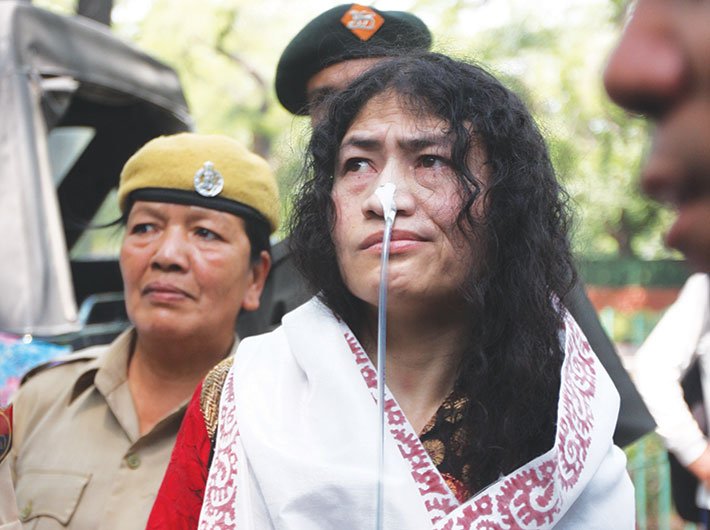Should attempt to suicide be considered a crime? Law commission and govt have repeatedly spoken against section 309 but it is yet to be removed
On March 30, Manipuri activist Irom Sharmila was acquitted by a Delhi court in an attempt-to-suicide case registered against her in 2006 for sitting on fast at Jantar Mantar in protest against a law giving special powers to the armed forces to deal with insurgency in certain parts of the country. While the acquittal needs to be welcomed, Irom may have faced criminal proceedings for about 10 years under a law which the society can do without.
Apart from law commission reports and judicial decisions favouring decriminalisation of attempt to commit suicide, the government has also proposed deletion of section 309 of IPC on a couple of occasions. But – pending reform – the provision not only continues to haunt suicide survivors, but also leaves scope for harassment of those using hunger strikes or fasts as means of protest.
While fasts or hunger strikes are undoubtedly lawful means of protest, section 309 – which does not define suicide – enables police to charge protesters on fast-unto-death or on hunger strike with attempt to commit suicide in certain circumstances. The thin line between a fast as a means of lodging protest and a fast which could be seen as an attempt to commit suicide allows selective invocation of section 309 against protesters who are difficult to deal with.
Section 309, which prescribes imprisonment of up to one year or fine or both, can be invoked against “whoever attempts to commit suicide and does any act towards the commission of such offence”.
While it may be harsh to punish a person surviving a clear attempt to die (who, on the contrary, deserves sympathetic treatment), there is no confusion with regard to application of section 309 in such cases. But there can be two opinions on application of the provision against those who sit on fast-unto-death or on hunger strike to press their demands.
The offence, as per section 309, is made out if one “attempts to commit suicide” and “does any act towards the commission of such offence”. The word ‘and’ shows that merely doing an act towards commission of suicide (fast-unto-death) may not be enough. In my opinion, there also has to be a clear intent to die as the phrase ‘attempt to commit suicide’ presupposes intent to put an end to one’s life.
Though invocation of section 309 against those on fast-unto-death has generally led to acquittals, courts have given liberal interpretation to the penal provision leading to activists facing the ignominy of protracted trial rather than getting discharged at the outset.
Take the case of Irom Sharmila. She may have been on fast which could be considered an act towards commission of suicide. She, however, clearly did not intend to die (attempt to commit suicide) but was on fast with a legitimate expectation of her demand being fulfilled. The court, however, framed charges and gave an opportunity to the police to prove the charge in trial. The Manipuri activist, who is being fed with the help of a pipe passing through her nose since she began her fast in 2000, would not have been alive in 2006 (when booked in Delhi) if she intended to commit suicide.
This was not an isolated case where section 309 was invoked against a protester. In 2013, 81-year-old Swami Gyan Swaroop Sanand, a former IIT professor also known by the name of GD Aggarwal, was sent to jail by a Haridwar court for sitting on fast to protest against government apathy towards the need for rejuvenating the river Ganga.
In Irom Sharmila’s case, the court relied on judgments by the Allahabad high court and the Madras high court and went into evidence to see if her act had taken her close enough to the goal of fasting to death so as to qualify as an attempt. The answer was in the negative.
The use of some amount of force to feed a person on fast-unto-death in protest may be justified but prosecution and trial of such a person serves no social purpose and only amounts to harassing activists or deterring protests. Besides, invoking section 309 against protesters does not inspire confidence in a democracy, particularly when the government on more than one occasion had made a commitment to delete the penal provision.
The present government informed parliament in December 2014 about its intention to repeal section 309 as per the recommendations made by the law commission in its 210th report in 2008. It also pointed out that a vast majority of states had supported the move. The governments in the past had made similar commitments and had even taken steps in this direction but such actions mean nothing until they lead to a change in the law.
The law commission had first recommended repeal of section 309 in its 42nd report in 1971. Subsequently, a bill to delete section 309 was introduced in the Rajya Sabha which passed it in 1978, but the bill lapsed with the dissolution of the Lok Sabha in 1979.
Finding the provision to be irrational and unjustifiable, courts tried to make amends in the 1980s. Terming section 309 as “an anachronism unworthy of human society like ours”, justice R Sachar in 1985 freed 120 people who were facing trial under the provision in Delhi by quashing their cases.
In 1987, the Bombay high court held section 309 as unconstitutional. The supreme court approved the view in the P Rathinam case in 1994 and quashed the provision “to humanise our penal laws”.
Since legal reform is a complex process requiring legislative intervention, the Rathinam judgment holding that the ‘right to life’ included the ‘right to die’ did not rule the field for long. It was overruled by the 1996 Gian Kaur judgment which revived section 309.
Ironically, the petitioners in the Gian Kaur case, who had challenged their conviction under section 306 for abetting suicide, had argued that they could not be punished for abetting suicide as the right to die had been held to be a fundamental right in the Rathinam case. “Any person abetting the commission of suicide by another is merely assisting in the enforcement of the fundamental right under Article 21,” the petitioner had argued, forcing the court to review its decision.
The deliberations in the Gian Kaur case showed that legislative intervention was the only viable option for reform as mere quashing of section 309 would not serve the desired purpose. If section 309 is repealed, no person can be prosecuted for abetting attempt to commit suicide. For this, an amendment would be required in section 306 which, in its present form, criminalises only ‘abetment to commit suicide’ and not ‘abetment to attempt to commit suicide’.
With the judiciary failing to provide a stable legal framework, it has since rightly requested the government to consider review of section 309 in a number of decisions. While the Gian Kaur verdict undid the reform attempted by the judiciary through the Rathinam judgment, the UK took the legislative route and decriminalised suicide in one stroke with the enactment of the Suicide Act, 1961.
While the judiciary may be able to check misuse of the provision against people on fast protest, our law, until repeal of section 309, will continue to treat as criminals suicide survivors who deserve our sympathy. It may not be in the interest of the society to give a person the ‘right to die’ but it is repelling to punish someone who is not an accused in the real sense of the term but rather a victim. Should a woman be punished for attempting suicide on account of abetment/cruel treatment by her in-laws? Should a rape victim attempting suicide be prosecuted? The provision squarely applies to such cases.
Further, section 309 hardly serves any social purpose as no punishment can be a deterrent for someone who willingly inflicts the greatest harm one can cause to himself. Though attempt to suicide was made an offence under our penal code which was enacted by the colonial government in 1860, India has had a tradition of some people choosing to die by giving up food after a certain age.
At the age of 87 in 1982, Acharya Vinoba Bhave decided to voluntarily end his life and went on a fast unto death. Social acceptance was evident from the fact that the then prime minister and other dignitaries converged to bid farewell after his death. A year later in 1983, Acharya Bhave was conferred with the Bharat Ratna.
In September last year, the supreme court stayed a Rajasthan high court order which held as suicide the religious practice among Jains to fast until death. The matter is pending a final decision.
(The column appears in the April 16-30, 2016 issue)

